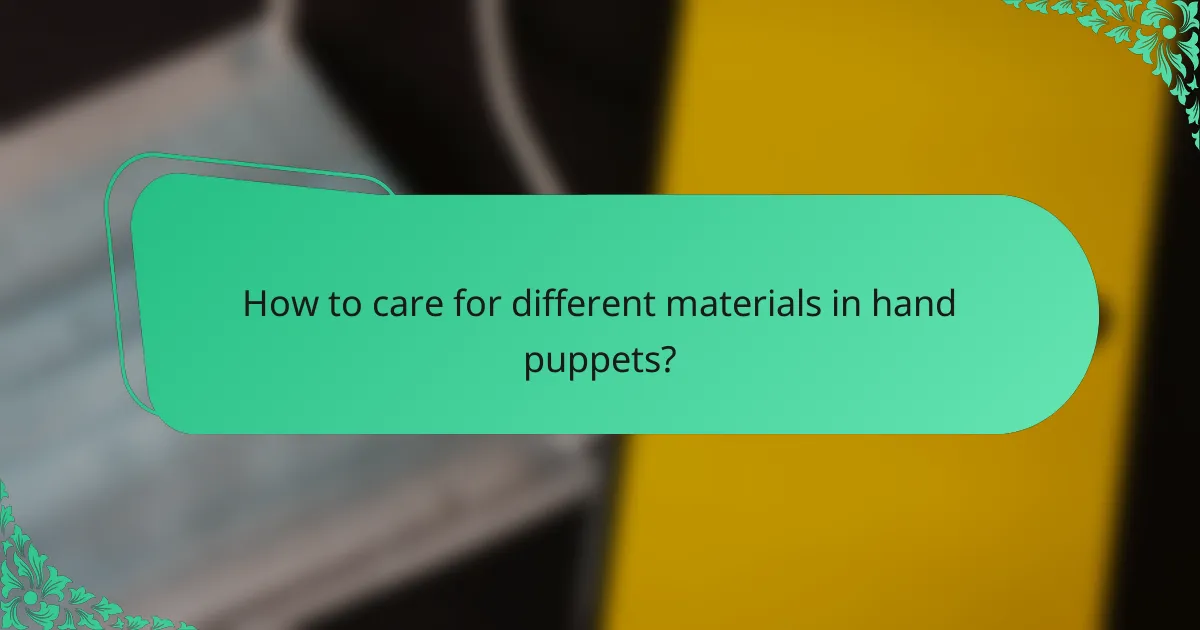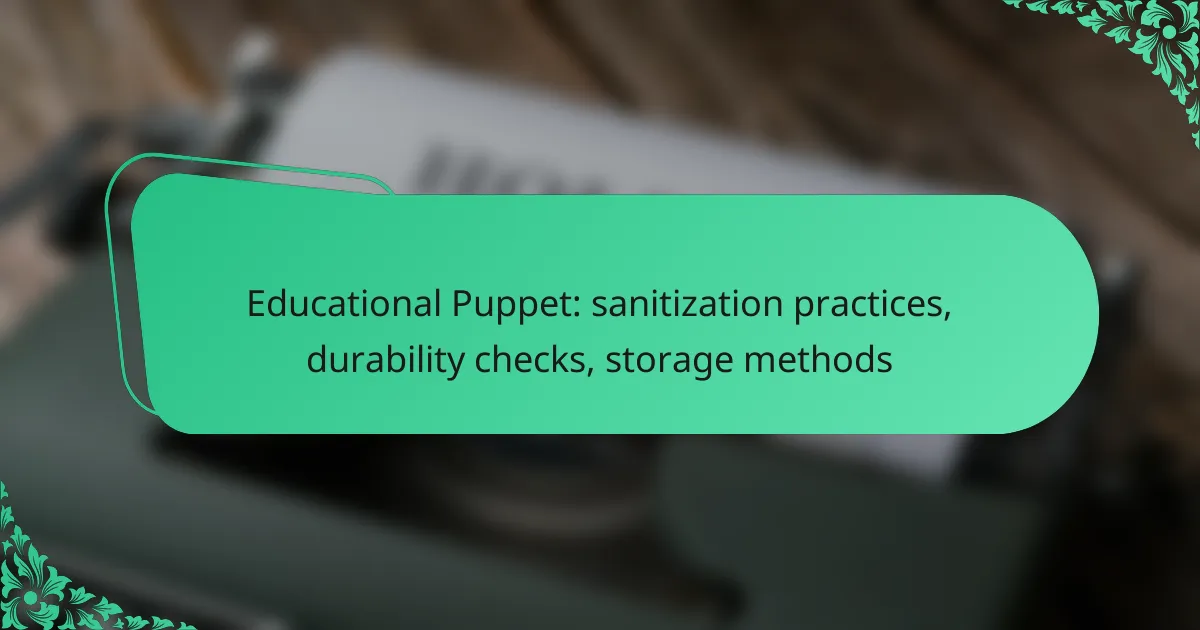Hand puppets are delightful tools for storytelling, but they require proper care to maintain their charm and functionality. Cleaning methods should be tailored to the specific materials used, ensuring both hygiene and preservation. Additionally, proper storage is crucial to prevent damage and extend the life of these beloved creations.

How to clean hand puppets effectively?
Cleaning hand puppets requires careful attention to their materials and construction. Using the right methods ensures they remain in good condition while being hygienic for use.
Spot cleaning with mild soap
Spot cleaning is ideal for small stains or dirt on hand puppets. Use a soft cloth or sponge dampened with a solution of mild soap and water to gently dab the affected area.
After cleaning, rinse the area with a clean, damp cloth to remove any soap residue. Avoid soaking the puppet, as excessive moisture can damage its structure and materials.
Machine washing for fabric puppets
Many fabric puppets can be machine washed, but check the care label first. Use a gentle cycle with cold water and place the puppet in a mesh laundry bag to protect it during the wash.
It’s advisable to use a mild detergent and avoid bleach or fabric softeners, which can degrade the puppet’s materials. After washing, inspect for any damage before drying.
Hand washing techniques
Hand washing is a safe method for delicate puppets. Fill a basin with lukewarm water and a small amount of mild detergent, then submerge the puppet and gently agitate the water.
Focus on soiled areas, using your fingers to work the soap into the fabric. Rinse thoroughly with clean water to ensure all soap is removed, as residue can attract dirt.
Drying methods for puppets
After cleaning, drying your puppet properly is crucial. Avoid direct sunlight and high heat, which can warp or fade materials. Instead, lay the puppet flat on a clean towel to air dry.
For fabric puppets, you can also hang them in a well-ventilated area. Ensure they are completely dry before storing to prevent mildew or odors.

What are the best storage tips for hand puppets?
To ensure the longevity of hand puppets, proper storage is essential. Keeping them in suitable conditions prevents damage and maintains their appearance and functionality.
Using breathable storage bags
Breathable storage bags are ideal for protecting hand puppets from dust and moisture while allowing air circulation. Look for bags made from cotton or linen, as these materials help prevent mold and mildew. Avoid plastic bags, which can trap humidity and lead to deterioration.
When using breathable bags, ensure they are large enough to avoid crushing the puppets. You can label each bag for easy identification, especially if you have a diverse collection.
Storing puppets in a cool, dry place
Hand puppets should be stored in a cool, dry environment to prevent damage from heat and humidity. Ideal storage temperatures are typically between 15°C and 25°C (59°F to 77°F). Avoid areas near radiators, direct sunlight, or damp basements.
Consider using a dehumidifier in particularly humid climates to maintain optimal conditions. Regularly check the storage area for any signs of moisture or pests that could harm the puppets.
Organizing puppets by size and type
Organizing hand puppets by size and type makes it easier to find and access them when needed. Grouping similar puppets together helps prevent tangling and damage. For instance, keep larger puppets separate from smaller ones to avoid crushing.
Using shelves or bins can help maintain organization. Label each section clearly, and consider using dividers to keep different types of puppets distinct, such as animal puppets versus character puppets.

How to care for different materials in hand puppets?
Caring for hand puppets involves understanding the specific materials used in their construction. Each type of material requires tailored cleaning and maintenance methods to ensure longevity and performance.
Caring for felt puppets
Felt puppets are generally easy to clean but require gentle handling. Use a soft brush or a lint roller to remove dust and debris. For stains, lightly dab with a damp cloth and mild soap, avoiding soaking the felt.
To maintain the shape and texture, store felt puppets flat or hanging, rather than crumpled. Avoid exposure to direct sunlight, which can fade colors over time.
Maintaining plush puppets
Plush puppets often require more careful cleaning due to their soft fabric. Most can be machine washed on a gentle cycle, but check for any removable parts that may need hand washing. Use a mild detergent and air dry to prevent damage.
For regular maintenance, brush the plush surface to keep it looking fresh and fluffy. Store plush puppets in a cool, dry place to prevent mold and mildew growth.
Cleaning wooden puppets
Wooden puppets need minimal cleaning but should be handled with care to avoid scratches. Wipe them down with a soft, dry cloth to remove dust. For deeper cleaning, use a slightly damp cloth, ensuring no water seeps into joints or painted areas.
To preserve the finish, avoid exposing wooden puppets to extreme temperatures or humidity. Store them in a protective case or on a shelf away from direct sunlight to maintain their appearance and integrity.

What are the common mistakes in puppet care?
Common mistakes in puppet care include neglecting material-specific instructions, using harsh cleaning chemicals, and employing improper drying techniques. These errors can lead to damage, reduced lifespan, and compromised performance of hand puppets.
Ignoring material-specific instructions
Each puppet is made from different materials, such as fabric, foam, or plastic, which require specific care instructions. Ignoring these guidelines can result in fading colors, weakened structures, or even irreversible damage. Always check the manufacturer’s recommendations for cleaning and maintenance.
For example, some fabrics may be machine washable, while others might require spot cleaning only. Familiarizing yourself with the material type will help you choose the right cleaning method and prolong the puppet’s life.
Using harsh chemicals
Harsh chemicals can degrade puppet materials, leading to discoloration or deterioration. Avoid using bleach, strong detergents, or abrasive cleaners that can harm delicate fabrics or finishes. Instead, opt for mild soap solutions or specialized puppet cleaning products.
When cleaning, test any solution on a small, inconspicuous area first to ensure it does not cause damage. This precaution can save you from costly repairs or replacements.
Improper drying techniques
Improper drying can warp or shrink puppet materials, especially if they are exposed to direct heat or sunlight. After washing, gently reshape the puppet and allow it to air dry in a cool, shaded area. Avoid using a dryer or placing it near radiators.
For puppets with intricate designs or electronics, ensure they are completely dry before storage to prevent mold or mildew growth. A good practice is to check for moisture in seams and crevices before putting the puppet away.

How to choose the right cleaning products for puppets?
Selecting the right cleaning products for puppets is crucial to maintain their appearance and longevity. Look for gentle, non-toxic options that effectively remove dirt without damaging the materials used in puppet construction.
Choosing eco-friendly detergents
Eco-friendly detergents are formulated to be safe for both the environment and the materials of your puppets. Look for products labeled as biodegradable and free from harsh chemicals, which can be harmful to both puppets and the planet.
When selecting an eco-friendly detergent, consider those with natural ingredients like plant-based surfactants. Brands that emphasize sustainability often provide effective cleaning solutions without compromising puppet integrity.
Avoiding allergens in cleaning supplies
To avoid allergens in cleaning supplies, choose products that are hypoallergenic and free from common irritants such as fragrances and dyes. This is especially important if the puppets will be used by children or individuals with sensitivities.
Always check the ingredient list for potential allergens and opt for products that have been dermatologically tested. Conducting a patch test on a small, inconspicuous area of the puppet can also help ensure that the cleaning product won’t cause any adverse reactions.

What are the emerging trends in puppet care and maintenance?
Emerging trends in puppet care and maintenance focus on sustainability, innovative cleaning methods, and proper storage techniques. As puppetry gains popularity, enthusiasts are increasingly adopting eco-friendly materials and practices to preserve their puppets while ensuring longevity.
Cleaning methods for hand puppets
Cleaning methods for hand puppets vary based on the materials used. For fabric puppets, gentle hand washing with mild soap is often recommended, while plastic or rubber puppets can be wiped down with a damp cloth and a mild disinfectant.
Always check the manufacturer’s guidelines for specific cleaning instructions. Avoid harsh chemicals that can damage the puppet’s material or colors. For delicate puppets, spot cleaning is preferable to maintain their integrity.
Storage tips for hand puppets
Proper storage is essential to maintain the shape and condition of hand puppets. Store them in a cool, dry place away from direct sunlight to prevent fading and material degradation. Using breathable fabric bags can help protect them from dust while allowing air circulation.
Consider using a dedicated storage box with dividers to keep puppets organized and prevent them from getting crushed or tangled. Regularly inspect stored puppets for signs of wear or damage, and address any issues promptly to prolong their lifespan.
Material care for hand puppets
Material care for hand puppets involves understanding the specific needs of each type of puppet. For example, wooden puppets may require occasional polishing with a suitable wood conditioner, while plush puppets benefit from regular brushing to maintain their texture.
Be mindful of the specific care instructions for each material. For instance, synthetic fibers may be machine washable, while natural fibers often require hand washing. Always air dry puppets to avoid shrinking or warping from heat exposure.










